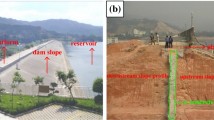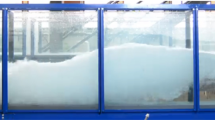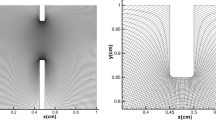Abstract
Stilling basins dissipate energy to form hydraulic jumps and rotational flows. Hydraulic jump and rotational current phenomenon produce pressure fluctuation at the bottom of stilling basins. In the present study, pressure fluctuations and their locations have been studied in a physical model of Namrod Dam. Results showed that fluctuations in presence of jump in the basin are high and, therefore, the fluctuation factors are, respectively, high. In positive pressure coefficient (C + P ), it is evident that when a jump is present, the turbulence and disturbance factors increase and, therefore, the pressure fluctuations go up, respectively. In negative pressure coefficients (C − P ), as is expected from positive pressure coefficients, the maximum pressure fluctuations occurred at Q/Q max = 0.47 with regard to forming a complete hydraulic jump at this discharge. Regarding available empirical equations, the thickness of slab for different hydraulic conditions was calculated and compared in one-dimensional (1D) and two-dimensional (2D) conditions. By analyzing collected data, it was observed that, results of 1D were underestimated in comparison to 2D calculations. Concrete slab thickness could be observed that fluctuations have significant effect on thicknesses. However, such calculations can provide designers with general ideas on how to better understand the conditions.








Similar content being viewed by others
Abbreviations
- B :
-
Width of stilling basin
- C:
-
Center
- C P ′:
-
The dimensionless RMS of the pressure fluctuations
- C + P :
-
Positive pressure coefficient
- C − P :
-
Negative pressure coefficient
- Fr1 :
-
Froude Number
- g :
-
Acceleration of gravity
- L :
-
Left
- L j :
-
Length of hydraulic jump for horizontal stilling basins
- N :
-
Total number of time intervals
- P :
-
Pressure at given time interval
- \( \bar{P}_{ - } \) :
-
Mean pressure
- \( P_{\hbox{max} }^{ + } \) :
-
Maximum positive pressure
- \( P_{\hbox{max} }^{ - } \) :
-
Maximum negative pressure
- Q :
-
Discharge
- Q max :
-
Maximum discharge
- R :
-
Right
- S :
-
Slab thickness without reinforcement
- S 1 :
-
One-dimensional slab thickness without reinforcement
- V 1 :
-
Mean velocity of flow entering stilling basin
- V i :
-
Inflow velocity
- X :
-
Distance from start of stilling basin along a longitudinal direction
- Y :
-
Distance from start of stilling basin along a cross section
- y 1 :
-
Primary depth
- y 2 :
-
Secondary depth
- y 2/y 1 :
-
Conjugate depths in hydraulic jump
- \( \Delta P_{\hbox{max} }^{ + } \) :
-
Maximum positive pressure deviation from the mean
- \( \Delta P_{\hbox{max} }^{ - } \) :
-
Maximum negative pressure deviation from the mean
- Σ:
-
Standard deviation or RMS
- Α :
-
A function of the velocity
- Ω :
-
Dimensionless reduction factor in Eq. 9
- γ w :
-
Specific weight of water
- γ c :
-
Specific weight of concrete
- −:
-
Average value
- ′:
-
Fluctuation
References
Farhoudi J, Narayanan R (1991) Force on slab beneath hydraulic jump. J Hydraul Eng ASCE 117(1):64–82
Kavianpour MR (2002) The effective pressure on the chutes of stilling basins In: Proceedings of the 5th international conference on hyrdroscience engineering, Poland
Toso JW, Bowers EC (1988) Extreme pressures in hydraulic jump stilling basin. J Hydraul Eng ASCE 114(8):829–843
Elder RA (1961) Model–Prototype turbulence scaling. IX IAHR Congress, Dubrovnalk, pp 24–31
Bowers CE, Toso J (1988) Karnafuli project, model studies of spillway damage. J Hydraul Eng ASCE 114(5):469–483
Vasiliev OF, Bukreyev VI (1967) Statistical characteristics of pressure fluctuations in the region of hydraulic jump. In: Proceedings of the 12th congress of the international association for hydraulic research. Colorado State University, Fort Collins, Colorado, 11–14 Sep, vol 2, pp 1–8
Schiebe F (1971) The stochastic characteristics of pressure fluctuations on a channel bed due to the turbulence in a hydraulic jump. PhD thesis, The University of minnesota, Minneapolis, US
Resch FJ, Leutheusser JH (1972) Le ressaut hydraulique: mesures de turbulence dans la region diphasique. Houille Blanche 4:279–293
Akbari ME, Mittal MK, Pande PK (1982) Pressure fluctuations on the floor of free and forced hydraulic jumps. In: International Conference on the Hydraulic modelling of civil engineering structures CI. Coventry, England, 22–24 Sep, pp 87–96
Lopardo RA, Henning RE (1985) Experimental advances on pressure fluctuations beneath hydraulic jumps. In: Proceedings of 21st International Association of Hydraulic Research Biennial Congress. Melbourne, Australia, vol 3, pp 633–638
Fiorotto V, Rinaldo A (1992) Fluctuating uplift and linings design in spillway stilling basins. J Hydraul Eng ASCE 118(4):578–596
Fiorotto V, Rinaldo A (1992) Turbulent pressure fluctuations under hydraulic jumps. J Hydraul Res 30(4):499–520
Bellin A, Fiorotto V (1995) Direct dynamic force measurement on slabs in spillway stilling basins. J Hydraul Eng 121(10):686–693
Hassonizadeh H, Shafai-Bajestan M (2001) Experimental measurement of dynamic force on slab in stilling basins. In: Proceedings of wetlands engineering and river restoration conference. Reno, Nevada, US
Guven A, Gunal M, Cevik A (2006) Prediction of pressure fluctuations on sloping stilling basins. Can J Civil Eng 33:1379–1388
Pei-Qing L, Ai-Hua L (2007) Model discussion of pressure fluctuations propagation within lining slab joints in stilling basins. J Hydraul Eng ASCE 133(6):618–624
Farhoudi J (2009) Total pressure around chute blocks of SAF stilling basins. Int J Civil Eng 7(4):271–279
Cerezera SM, Muller D, Clarke RT, Marques MG (2010) Pressure extrema in energy-dissipating structure using block maxima. J Hydraul Res 48(4):483–490
Chau KW, Jiang YW (2001) 3D numerical model for pearl river estuary. J Hydraul Eng ASCE 127(1):72–82
Chau KW, Jiang YW (2004) A three-dimensional pollutant transport model in orthogonal curvilinear and sigma coordinate system for pearl river estuary. Int J Environ Pollut 21(2):188–198
Wu CL, Chau KW (2006) Thematical model of water quality rehabilitation with rainwater utilization—a case study At Haigang. Int J Environ Pollut 28(3/4):534–545
Margot X, Hoyas S, Gil A, Patouna S (2012) Numerical modelling of cavitation: validation and parametric studies. Eng Appl Comput Fluid Mech 6(1):15–24
Mahmoud H, Kriaa W, Mhiri H, Le Palec G, Bournot P (2012) Numerical analysis of recirculation bubble sizes of turbulent co-flowing jet. Eng Appl Comput Fluid Mech 6(1):58–73
W.R.I. (Water Research Institute) (2006) Physical Model of Namrod Stilling Basin. Technical Report, Tehran, Iran
US bureau of reclamation (1984) Hydraulic design of stilling basins and energy dissipators, 8th edn. US Department of the Interior, Washington, DC
Kamaei-Rostami AR, Fathi-Moghadam M, Safarpour M, Behrouzi-Rad R (2009) Effect of discharge and depth of downstream water in Namrod Dam’s spillway stilling basin on dynamic pressure of basin floor using physical model. In: Proceedings of the 8th international conference in civil engineering, Shiraz University, Shiraz, Iran
Acknowledgments
The authors would like to thank Water Research Institute (WRI), Tehran, Iran, for their support and assistance with this research.
Author information
Authors and Affiliations
Corresponding author
Rights and permissions
About this article
Cite this article
Kazemi, F., Khodashenas, S.R. & Sarkardeh, H. Experimental Study of Pressure Fluctuation in Stilling Basins. Int. J. Civ. Eng. 14, 13–21 (2016). https://doi.org/10.1007/s40999-016-0008-3
Received:
Revised:
Accepted:
Published:
Issue Date:
DOI: https://doi.org/10.1007/s40999-016-0008-3




